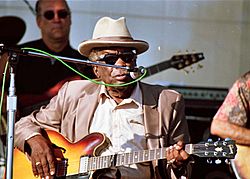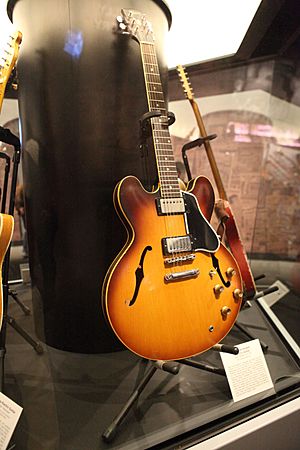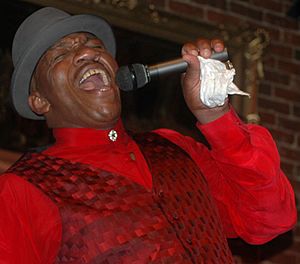John Lee Hooker facts for kids
Quick facts for kids
John Lee Hooker
|
|
|---|---|

John Lee Hooker at the Long Beach Blues Festival, 1997
|
|
| Background information | |
| Born | August 22, 1917 Coahoma County, Mississippi |
| Died | June 21, 2001 (aged 83) |
| Genres | Blues |
| Occupation(s) | singer-songwriter |
| Instruments | Guitar |
| Years active | 1948-2001 |
| Labels | Vee-Jay, Chess Records and others |
John Lee Hooker (born August 22, 1917 – died June 21, 2001) was a famous American blues singer, songwriter, and guitarist. He grew up on a farm and became well-known for his unique electric guitar style, which came from Delta blues music.
Hooker created his own special "boogie" rhythm style. Some of his most famous songs include "Boogie Chillen'" (from 1948), "Crawling King Snake" (from 1949), "Dimples" (from 1956), and "Boom Boom" (from 1962). Many of his later albums, like The Healer (1989) and Don't Look Back (1997), were very popular. He won several Grammy Awards for his music, including one for "I'm In The Mood" and two for the album Don't Look Back.
Contents
Early Life of John Lee Hooker
John Lee Hooker's exact birth year is debated, but most sources say he was born in 1917. He was likely born in Tutwiler, Mississippi, or near Clarksdale, Mississippi. He was the youngest of 11 children. His father was a farmer and a Baptist preacher.
The Hooker children were taught at home. They were only allowed to listen to religious songs, which was their first experience with music. In 1921, his parents separated. The next year, his mother married William Moore, a blues singer. Moore taught John Lee how to play the guitar and greatly influenced his unique style.
Another important influence was Tony Hollins, who was dating Hooker's sister. Hollins also helped teach Hooker to play and gave him his first guitar. Hollins taught him songs like "Crawlin' King Snake".
When he was 14, Hooker left home. In the mid-1930s, he lived in Memphis, Tennessee, where he performed on Beale Street. During World War II, he worked in factories in different cities. He eventually got a job with the Ford Motor Company in Detroit in 1943. In Detroit, he often visited the blues clubs on Hastings Street. Guitar players were rare there, so Hooker quickly became popular. He bought his first electric guitar to play louder in the clubs.
Starting His Music Career
John Lee Hooker's recording career began in 1948. A company called Modern Records released a song he had recorded called "Boogie Chillen'" (pronounced "Boogie Chillin'"). This song became a huge hit and was the best-selling "race record" (a term for music by Black artists) in 1949.
Even though he couldn't read or write, Hooker wrote many songs. In the 1950s, like many Black musicians, he didn't earn much money from record sales. So, he often recorded different versions of his songs for various studios to get paid upfront. To avoid problems with his contracts, he used many different names. Some of these names included John Lee Booker, Johnny Lee, Texas Slim, and the Boogie Man.
Later Career and Passing
Starting in 1962, Hooker became more famous when he toured Europe. His song "Dimples" became a hit in the UK in 1964. Hooker also began to play and record with rock musicians. He worked with the British band the Groundhogs.
In 1970, he recorded an album called Hooker 'n Heat with the American band Canned Heat. This album was the first of Hooker's albums to appear on the Billboard charts, reaching number 78. Other albums with collaborations soon followed, including Endless Boogie (1971) and Never Get Out of These Blues Alive (1972). These albums featured musicians like Steve Miller and Van Morrison.
Hooker appeared in the 1980 movie The Blues Brothers. He played a street musician and performed his song "Boom Boom" in the film. In 1989, he recorded the album The Healer with famous artists like Carlos Santana and Bonnie Raitt. The 1990s brought more collaboration albums, such as Mr. Lucky (1991), Chill Out (1995), and Don't Look Back (1997). These albums included guest musicians like Morrison, Santana, and Los Lobos. His re-recorded version of "Boom Boom" with guitarist Jimmie Vaughan became his highest-charting song in the UK, reaching number 16.
John Lee Hooker passed away peacefully in his sleep on June 21, 2001, in Los Altos, California. He is buried in Oakland, California. He was survived by his eight children, 19 grandchildren, and many great-grandchildren.
Awards and Recognition
John Lee Hooker received many awards for his music. He was added to the Blues Hall of Fame in 1980 and the Rock and Roll Hall of Fame in 1991. He received the Grammy Lifetime Achievement Award in 2000, which is a very special honor for a musician's entire career. He also has a star on the Hollywood Walk of Fame.
Two of his songs, "Boogie Chillen" and "Boom Boom", are on the Rock and Roll Hall of Fame's list of the "500 Songs That Shaped Rock and Roll". "Boogie Chillen" is also on the Recording Industry Association of America's list of the "Songs of the Century". In 2007, John Lee Hooker was voted into the Michigan Rock and Roll Legends Hall of Fame.
Grammy Awards
- Best Traditional Blues Recording, 1990, for I'm in the Mood, with Bonnie Raitt
- Best Traditional Blues Album, 1995, for Chill Out
- Best Traditional Blues Recording, 1998, for Don't Look Back
- Best Pop Collaboration with Vocals, 1998, Don't Look Back, with Van Morrison
- Grammy Lifetime Achievement Award, 2000
Images for kids
See Also
 In Spanish: John Lee Hooker para niños
In Spanish: John Lee Hooker para niños





